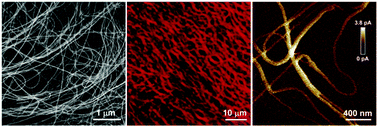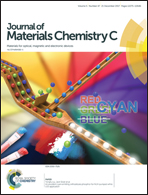Phosphorescent and semiconductive fiber-like micelles formed by platinum(ii) complexes and block copolymers†
Abstract
The electrostatic self-assembly of cationic platinum(II) complexes with negatively charged block copolymers in water leads to the formation of fiber-like micelles with a platinum(II)-based ionic core surrounded by a poly(ethylene oxide) corona. The structural details are well documented by various microscopic observations, small-angle X-ray scattering, and wide-angle X-ray scattering. In the fiber-like micelles, the superstrong segregation regime appears unexpectedly, where the half widths of the ionic cores correspond to the lengths of fully stretched anionic blocks. Both the phosphorescent intensities and quantum yields increase remarkably, due to the presence of strong Pt(II)⋯Pt(II) and π–π stacking interactions. Conductive atomic force microscopy measurements reveal that the individual nanofibers possess recognizable conductivity. The semiconductive behaviors are further supported by electrochemical impedance measurements. The negative slopes obtained from Mott–Schottky plots of 1/C2versus potential suggest that these nanofibers are p-type semiconductors. However, in the fiber-like micelles, the intense phosphorescence occurs synchronously with the appreciable conductivity. Considering highly available square-planar d8 transition metal complexes that prefer to form metal–metal and π–π stacking interactions, the present strategy represents a novel approach for exploring intensely phosphorescent and appreciably conductive fiber-like materials.



 Please wait while we load your content...
Please wait while we load your content...